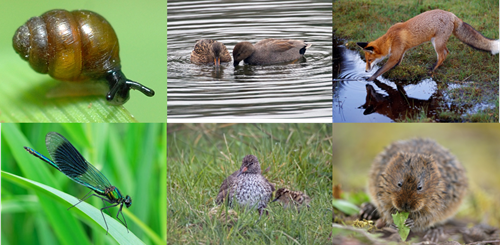The Avon Catchment is one of the most bio diverse river systems in lowland Britain, supporting a very rich diversity of flora, fish, birds and invertebrate fauna more so than any other chalk river in Britain. Within the overall catchment, there are two areas of natural beauty, two environmentally sensitive areas, nine special areas of conservation (SAC) and 71 sites of species scientific interest. The lower reaches are classified as a RAMSAR site and includes several of the overall designated sites. This clearly demonstrates the importance of the lower Avon Valley for a whole host of species.
The lower valley hosts a nationally important assemblage of breeding wetland birds, particularly those associated with lowland wet grassland such as lapwing (Vanellus vanellus) and redshank (Tringa tetanus). Historically, the site was listed as of the eight most important areas in Britain for these species, though their populations have experienced declines in recent times. Notable regularly recorded breeding songbird species include cetti’s warbler (Cettia cetti), reed warbler (Acrocephalus scirpaceus) and reed bunting (Emberiza schoeniclus). Though not regularly recorded, low numbers of the red-listed nightingale (Luscinia megarhynchos) remain breeding in the valley.
In addition to breeding birds, the lower supports nationally or internationally important populations of 5 species of wintering waterfowl or waders including 3.1% of the UK population of wintering Gadwall and nationally important populations of wintering Black-tailed Godwit, Shoveler and Pintail.
Over 180 species of aquatic plant have been recorded within the river, with further diversity in the accompany species-rich grasslands. There are still limited areas of diverse MG8 (Cynosurus cristatus-Caltha palustris) swards, supporting species such as brown sedge (Carex disticha), fen bedstraw (Galium uliginosum), water avens (Geum rivale) and marsh valerian (Valeriana dioica). Alongside, scarce flora such as small fleabane (Pulicaria vulgaris) and mudwort (Limosella aquatica).
The river itself, is nationally one of the most diverse fish populations in Britain and is renouned for trout, grayling and salmon. Although these populations have faced pressures and experienced declines in recent decades. There are several projects focused on improving the status on the Avon Valley fish population. The range of river and wetland invertebrates the Avon Valley is richer and more varied than most rivers in the UK, including national important populations of Desmoulin’s whorl snail (Vertigo moulinsiana) and Pea mussel (Pisidium tenuilineatum).

Various Avon Valley wildlife (top right to bottom right): Desmoulin's whorl snail, gadwall, red fox, banded demoiselle, redshank and watervole.